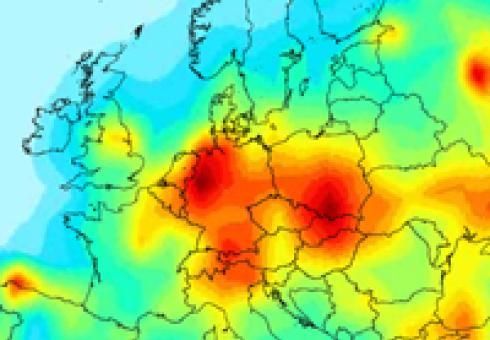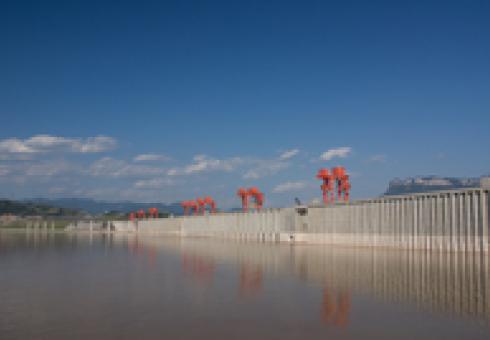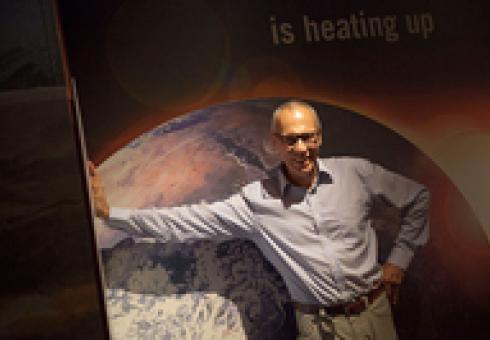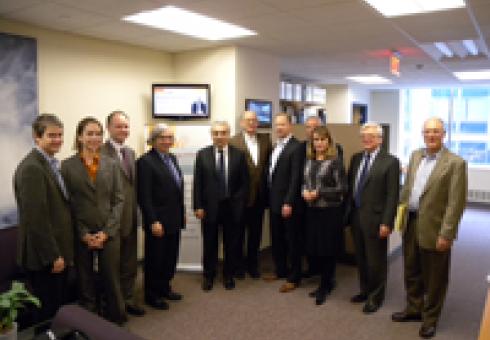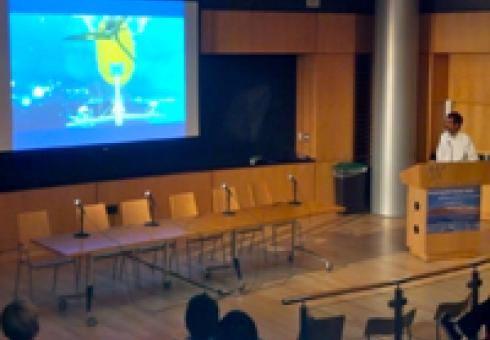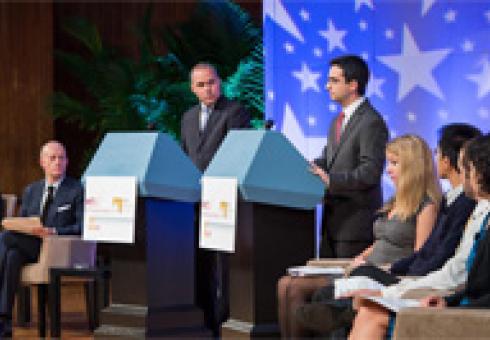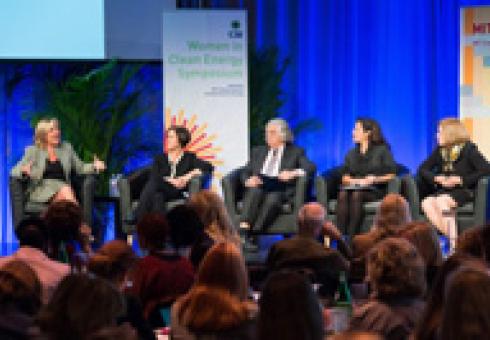News Releases
Karplus, Paltsev recieve award for study on the impacts of vehicle efficieny stanards
Valerie Karplus, Research Scientist, and Sergey Paltsev, Assistant Director for Economic Research with MIT’s Joint Program on the Science and Policy of Global Change, were awarded the 2012 Pyke Johnson Award at a ceremony last night during the annual meeting for the National Research Council's Transportation Research Board. The Pyke Johnson Award recognizes the best paper in the area of planning and the environment.
Published in November in the journal Transportation Research Record, the study looks into the new vehicle efficiency standards. The standards are considered one of the landmark environmental achievements of President Obama’s first term, and have been touted as a way to save consumers more than $1.7 trillion at the pump and cut vehicle emissions in half. Karplus and Paltsev look behind the numbers to understand the full energy and economic impacts. 
“Common thinking in Washington holds that any policy that seems to advance technology without creating new taxes must be a no brainer for the country. That misses the broader economic impact,” says Karplus. “As my colleague says, you may see more money in your front pocket at the pump, but you’re financing the policy out of your back pocket through your tax dollars and at the point of your vehicle purchase.”
Of the research, University of Maine environmental economist Jonathan Rubin, chair of the Transportation Energy Committee of the Transportation Research Board, says, “The research of Dr. Karplus on the energy and climate impacts of the nation’s fuel economy standards for our cars and trucks makes an important contribution to policy-making based on science.”
The new fuel standards require automakers to install pollution-control technology to improve the fuel efficiency of cars by 5 percent and light trucks by 3.5 percent with each new model year starting in 2017. Karplus and her colleague simulated the proposed standards, and found that while drivers of these more efficient vehicles will no doubt save at the pump, they could spend several thousands of dollars more when buying their new car. Even more troubling, diverting efforts toward improved vehicle efficiency distracts attention away from policies that would target the broader economy and reduce fuel use or emissions more cost effectively, such as a carbon tax.
Estimates of how costly the policy would be – in terms of both direct costs to consumers and the larger rippling costs to the economy – hinge on the relative cost of the technology available to improve efficiency. The shorter the time frame automakers are given to develop the technology and produce more efficient vehicles, the less time there will be for technological progress and other factors to drive down costs and the more consumers will need to pay upfront. Emissions and oil imports will drop – both due to increased fuel efficiency and as the higher vehicle costs weighs on consumer budgets – but will be offset as consumers face lower costs per mile traveled, incentivizing more driving.
Karplus hopes her results will help policymakers make more informed decisions going forward. She credits that to the innovative method she used, which weaves engineering and technology constraints into a broad economic framework and allows researchers to test the cost and other impacts of a policy at different levels of stringency. This method inherently takes account of life-cycle emissions, as well as impacts that transmit across fuel markets by affecting prices. For example, a policy might only consider gasoline use by plug-in electric hybrids, but that “tailpipe measure” doesn’t take into account the emissions created from building, transporting and recharging those batteries. Her approach does.
“There are a lot of hidden costs to a policy like this,” Karplus says. “This model doesn’t allow you to ignore other important aspects of the economy and energy systems. It requires you to be explicit about your technology and cost assumptions. It provides a framework that allows lawmakers to look at all the available information on costs and the state of the technology and decide how to best create or update policies.”
Harvard, MIT researchers map future trends of mercury and ways to reduce it on eve of international negotiations. 
International negotiators will come together next week in Geneva, Switzerland for the fifth and final meeting to address global controls on mercury. Ahead of the negotiations, researchers from MIT and Harvard University are calling for aggressive emissions reductions and clear public health advice to reduce the risks of mercury.
The researchers’ commentary, published this week in the journal Environmental Health, is in response to a study on the costs associated with mercury pollution in Europe. That study showed that as many as two million children in European Union nations are born each year with long-term IQ deficits due to unsafe levels of mercury exposure. These lower IQs can have spiraling effects on the earning potential of those impacted down the road, resulting in as much as 9,000 million euros in lost revenue a year.
But the authors of the commentary, Elsie Sunderland of Harvard and Noelle Selin of MIT, say mercury’s impact — and that of its toxic form methylmercury — extends far beyond the EU.
“Mitigating the harm caused by methylmercury requires global-scale cooperation on policies and source reductions,” Sunderland says.
Fish and other species, such as polar bears, can be harmed by mercury exposure. Once entered into the food chain, this exposure harms humans. In the near term, the public health community can advise changes in seafood consumption to control the risks, the researchers say. The critical action, however, comes in making significant progress in reducing mercury emissions to prevent an even greater increase in cycling “legacy” emissions.
“Most analyses forecasting mercury levels underestimate the severity of the situation because they don’t take the entire picture into account when looking at future mercury levels,” says Selin, an assistant professor of engineering systems and atmospheric chemistry.
Selin and Sunderland explain in their commentary that most mercury exposure comes from eating fish. Coal-fired power plants and other sources such as industrial activities emit mercury to the atmosphere. This mercury eventually rains down to the land and sea. In the ocean, mercury can convert to toxic methylmercury, and accumulate in the marine food chain. Mercury pollution settles deep within the ocean and circulates for decades and even centuries, continuously posing dangers to humans and the environment.
When considering future emissions, these “legacy” emissions are often not taken into account, but should be, the researchers say, because they make up a substantial amount of future emissions and could make already-dangerous levels of mercury even more threatening.
For example, mercury in the North Pacific Ocean — a large player in the global seafood market — is expected to double by 2050, from 1995 levels, due to new emissions. With the substantial “legacy” emissions that will circle back into the atmosphere, that amount is much greater. This increase in mercury could have dire impacts on fish from the Pacific Ocean.
“Not only will we see these ‘legacy’ emissions circle back up,” Selin says. “But with energy demands growing worldwide, we’ll see more new mercury entering the atmosphere, unless we act now to control this mercury at its source — and that’s largely coal-fired power plants.”
Sunderland and Selin say the United Nations Environment Program’s negotiations represent a sure step in the right direction. The question is: Will the talks produce real results?
In an interview with MIT News just prior to the first negotiating session in 2010, Selin said U.S. domestic politics would likely be a challenge to international cooperation on mercury. But last year, the U.S. Environmental Protection Agency finalized Mercury and Air Toxics Standards that require coal-fired power plants to install scrubbing technology that will cut 90 percent of their mercury emissions by 2015. With these standards — now the most stringent mercury standards of their kind in the world — Selin says the country has proven its leadership and provided some hope.
“These standards show that the U.S. is taking leadership at home to address a widespread and substantial global problem,” Selin says.
Selin, along with ten MIT graduate students, will present recent scientific results to negotiators in Geneva next week.
By: Vicki Ekstrom
MIT researchers enhance model to assess the risks of water stress. A conflict over water management has intensified along the Mississippi and Missouri rivers. Downstream states argue water should be released from the Missouri’s upstream reservoirs into the Mississippi to allow shipping to continue in the record low-level waters. Upstream states are fighting to keep the water to irrigate their crops and prevent the drought from getting even worse next year. To add to the tension, still others want to move a portion of the Missouri River Basin’s water to the Colorado Basin—which will see demand outstrip supply in the coming decades, according to a federal study released last week.
A conflict over water management has intensified along the Mississippi and Missouri rivers. Downstream states argue water should be released from the Missouri’s upstream reservoirs into the Mississippi to allow shipping to continue in the record low-level waters. Upstream states are fighting to keep the water to irrigate their crops and prevent the drought from getting even worse next year. To add to the tension, still others want to move a portion of the Missouri River Basin’s water to the Colorado Basin—which will see demand outstrip supply in the coming decades, according to a federal study released last week.
These are the stakes in the conflict over water, and the impacts could be profound and widespread. Agriculture, river navigation, energy and other industries all stand to lose as populations increase and the possible side effects of climate change emerge. To measure future changes on water resources, researchers at the Massachusetts Institute of Technology have enhanced their global model to include a new tool that assesses the risks of water stress.
“As fresh water sources throughout the world experience considerable stress because of an increasing population, economic growth, and droughts, floods and other climate effects, this tool will provide valuable insights to industries and communities competing for water,” says Ken Strzepek, a researcher at the MIT Joint Program on the Science and Policy of Global Change, who helped design the tool.
Strzepek and his colleagues Adam Schlosser and Élodie Blanc take population, GDP and other socio-economic factors and combine them with hydro-climatic information such as precipitation and runoff from their earth system model. They then combine this information to estimate changes in demand across sectors such as public and private water use, agricultural use and thermoelectric cooling used in energy production. The result is an expanded model that can forecast if and where there could be stresses within water basins, along with the risks surrounding those changes.
“Globally, the tool is helping us see where the hot spots for water stress are and where might that stress increase in the future due to human growth and climate change—two factors that are coming together and exacerbating the problem of water management,” says Schlosser, the assistant director of science research at the Joint Program on Global Change.
While the new model paints the picture globally, it can also be applied at a regional and even local scale to help communities make important decisions about their future energy investments, infrastructure plans and adaptation strategies. Uniquely, by incorporating risk and uncertainty, the model helps policymakers evaluate the question: What investments do we need to make to be better prepared?
“When looking at different climate models, not only do they show different results, they show different directions—one shows a positive change where another might show a negative change,” Schlosser says. “However, our technique allows us to quantify this uncertainty as risk to help decision makers formulate more robust investment plans.”
The researchers have already begun to apply their model to the U.S. While their findings are still being written, the researchers agree that critical water management issues will arise—and in some areas are already emerging. They are finding that the areas that will see the greatest stress going forward are the same places where very rigid water management laws already exist, such as around the Missouri, Mississippi and Colorado rivers.
“Our model framework is able to account for water management and allocation policies,” Schlosser says. “This allows us to take a situation like transferring water from the Missouri to the Colorado Basin and assess the impacts to both basins going forward.”
Drawing from this measure of risk, the researchers warn that decision makers in developing countries should make their adaptation plans both flexible and efficient.
“If we don’t know how much water will come down the river, we should design dams to be constructed in stages. For example, we should make provisions to add hydropower generation capacity easily and accordingly. ” Strzepek says. “We need to have flexible designs, and also efficient designs, so we’re building in a way that the structure will perform well under a variety of climates.”
Read more about the new tool here.
By: Alvin Powell, Harvard Staff Writer
Benefits, risks of using geoengineering to counter climate change.
 If they wanted to, nations around the world could release globe-cooling aerosols into the atmosphere or undertake other approaches to battle climate change, an authority on environmental law said Monday. He recommended international discussions on a regulatory scheme to govern such geoengineering approaches.
If they wanted to, nations around the world could release globe-cooling aerosols into the atmosphere or undertake other approaches to battle climate change, an authority on environmental law said Monday. He recommended international discussions on a regulatory scheme to govern such geoengineering approaches.
Under international law, nations can research and deploy such approaches on their own territory, on that of consenting nations, and on the high seas, said Edward Parson, a law professor at the University of California, Los Angeles. Despite that freedom, research into climate engineering remains stalled while opposition from environmental groups, fearful of unintended consequences, is growing,
Parson gave an overview on the policy challenges of climate engineering during a talk titled “International Governance of Climate Engineering” at the Science Center Monday evening. The session was part of a new series co-sponsored by the Harvard University Center for the Environment and the MIT Joint Program on the Science and Policy of Global Change.
Although several geoengineering approaches are feasible, Parson focused on one he said could be deployed most rapidly: spraying cooling aerosols high into the atmosphere. Nature has already proven such an approach to be effective. When volcanoes erupt, they spew sulfur compounds that reflect the sun’s radiation. Large eruptions can result in global-cooling events, volcanic winters lasting up to several years.
The approach would be fast and cheap but imperfect, Parson said. Aerosols could be sprayed from airplanes relatively inexpensively, for billions of dollars, with costs dropping. It would be an imperfect approach, Parson said, because although spraying aerosols would cool the Earth, it would not be a permanent fix. The effort would do nothing to stop the driving forces of warming: the emission of greenhouse gases. Also, the tactic would last only a year or two, and it wouldn’t address climate change’s other effects, such as acidification of the oceans and ecological changes.
Still, Parson said, the effort could mitigate climate effects that are rapidly worsening, or, more strategically, it could “shave the peak” from the worst warming while the world transitions to low-carbon energy, or it could be employed on a regional scale to mitigate localized problems, such as limiting the melting of sea ice during the Arctic summer or reducing sea surface warming in the regions where hurricanes form.
Of course, the prospect of such offbeat approaches also raises the specter of incompetent, negligent, or even malicious uses, Parson said. One of the largest potential threats involving climate engineering could come from nations’ militaries looking to ease domestic conditions at a neighbor’s expense.
International regulations could be drafted by the dozen or two dozen nations capable of carrying out such programs, Parson said. He suggested that such regulations should ban research that might have large-scale impact while allowing more responsible, smaller-scale work to proceed. He also advocated requirements for transparency and disclosure of results.
Parson said it is important to find out whether climate-engineering techniques can have a regional or global impact, and how much they might be fine-tuned to address local or regional problems. It also will be important to determine where nations’ interests lie. If their goals are aligned, he said, creating and executing a regulatory scheme will be far easier to do.
Though it may be difficult to get intransigent nations to the table, as their fear over climate change rises, so will their willingness to negotiate, he suggested.
“Nothing is politically impossible, contingent on the current level of alarm,” Parson said.
View picture from the event on our facebook page here.
Stay tuned for the next event here.
By: Vicki Ekstrom Fatih Birol, chief economist of the International Energy Agency (IEA), visited MIT on Wednesday, November 28 to present this year’s World Energy Outlook. While on campus, Birol met with researchers at the Joint Program on Global Change to learn about the latest developments on climate change policy and MIT’s Emissions Predictions and Policy Analysis (EPPA) model. The model is used by MIT researchers to make their own world economic and emissions projections.
Fatih Birol, chief economist of the International Energy Agency (IEA), visited MIT on Wednesday, November 28 to present this year’s World Energy Outlook. While on campus, Birol met with researchers at the Joint Program on Global Change to learn about the latest developments on climate change policy and MIT’s Emissions Predictions and Policy Analysis (EPPA) model. The model is used by MIT researchers to make their own world economic and emissions projections.
“We had a very productive discussion about the future of the world’s energy system development and advances in modeling alternative pathways. We also shared information about our current projects and future directions,” said Sergey Paltsev, assistant director for economic research at the MIT Joint Program on Global Change, after the meeting. “IEA’s World Energy Outlook is one the most comprehensive and authoritative sources in energy projections and related carbon emissions.”
Birol also commented on the usefulness of the exchange:
"As our World Energy Outlook 2012 shows, the global energy system is undergoing fundamental, rapid change. MIT's proven, interdisciplinary approach to research and education in energy and climate issues will be even more important in the years to come,” Birol said.
Named by Forbes magazine as one of the most influential people on the global energy scene, Birol chairs the World Economic Forum’s Energy Advisory Board and is often called on to brief high-level political figures — including President Barack Obama.
Birol’s meeting with Paltsev, along with MIT Global Change researchers Henry Jacoby and Valerie Karplus, came prior to an MIT Energy Initiative-hosted event on the IEA’s World Energy Outlook. The Outlook projects that the United States will become the world’s leading oil producer within a few decades, while gas will continue to be a major player. It also turns attention to climate change.
“As each year passes without clear signals to drive investment in clean energy, the ‘lock-in’ of high-carbon infrastructure is making it harder and more expensive to meet our energy security and climate goals,” said Birol when IEA released the Outlook on November 9.
The Outlook finds that four-fifths of the total energy-related carbon emissions permitted under a scenario that limits warming to 2°C, the globally-agreed goal, are already locked-in by existing capital stock such as power stations, buildings and factories. It warns that without further action by 2017, the energy-related infrastructure in place would generate all the carbon emissions allowed up to 2035. Delaying action is a false economy, the report says, noting that for every $1 of investment in cleaner technology that is avoided in the power sector before 2020, an additional $4.30 would need to be spent after 2020 to compensate for the increased emissions.
Read more about the Outlook in a special MIT News interview with Fatih Birol here.
Watching the Arctic Melt: Adventures in Polar Oceanography
by Genevieve Wanucha
One hundred people packed into the Whitehead Institute on November 19th to attend the Oceans at MIT special symposium, entitled ‘Watching the Arctic Melt: Adventures in Polar Oceanography.’ Most people there already knew that the Arctic Ocean’s ice cover goes through a cycle of seasonal growth and decline. Everyone had already heard that the Arctic Ocean sea ice cover hit a record minimum this fall. More surprising was the news that the Arctic, which has warmed twice the global average, may experience ice-free summers before 2050.
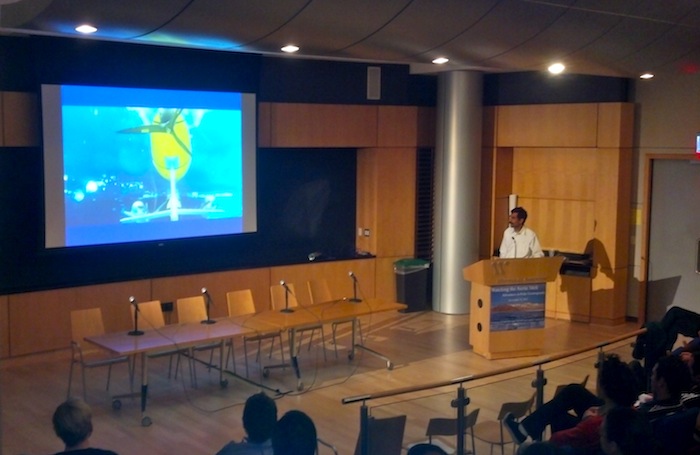
WHOI’s Hanu Singh suprises the audience with stunning images of an autonomous underwater vehicle. Singh and his lab members send these robots down through holes in Arctic sea ice to explore the underside of sea ice.
“This melting has enormous implications for shipping, fishing, Arctic ecology, oil and gas exploration, national security, and geopolitics,” said John Marshall, professor of oceanography at MIT, who kicked off the afternoon. “There is likely to be a ‘Gold Rush’ as the oil and gas resources in the Arctic become more available as it thaws.”
The event was a quintessential example of the close and longstanding collaboration between MIT and Woods Hole Oceanographic Institution, bringing together Arctic experts who are all pushing technical frontiers to study the high-stakes Arctic ice loss.
Their ultimate goal, as it soon became clear, is to be able to predict and model the behavior of the Arctic melting. However, that’s far from straightforward. As Patrick Heimbach, a principal research scientist in EAPS, emphasized, scientific prediction requires understanding—an understanding of, for instance, how ice sheets break apart and how ice interacts with the warming air above and water below. And understanding requires observation.
Fortunately, these speakers are bringing observation in the Arctic to the next level, especially John Toole, a senior scientist and chair of physical oceanography at WHOI who studies how the shrinking ice cap affects Arctic Ocean circulation. “Satellite data is useful, but it’s only skin deep,” he said as he took the stage. “It doesn’t give you information about the ocean interior.” So, he’s created tools to figure out what goes on below the ice.
Toole’s innovation, the “ice-tethered profiler,” is a buoy that sits atop the ice sheet, sending a wire down through the ice. A vehicle crawls up and down the wire, sending high-resolution data up to a satellite. His team has deployed 60 profilers since 2004 and will launch more next year. The huge amounts of data the profilers collect are allowing any researcher to track seasonal patterns in Arctic through measures of salinity, oxygen, water velocity, and photosynthetic radiation.
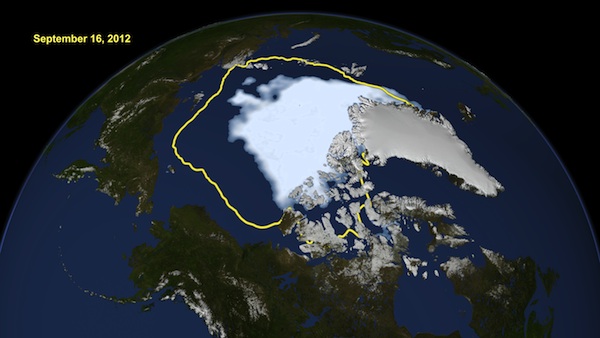
Satellite image of the new record low Arctic sea ice extent, from Sept. 16, 2012, compared to the average minimum extent over the past 30 years (in yellow). Credit: Credit: NASA/Goddard Scientific Visualization Studio
Art Baggeroer and Henrik Schmidt, both professors at MIT’s Ocean Seismo-Acoustic Laboratory MIT, reported on their efforts to observe the Arctic using sound. By recording the sound and seismic waves traveling in the Arctic Ocean, they can infer exactly how and why the sea ice is breaking up.
Carin Ashjian, a senior scientist in the biology department at WHOI, uses a range of acoustic and video methods to study the surprisingly active ecosystem alive under the ice sheet. She’s spent day traveling aboard icebreakers in harsh weather to collect data on zooplankton, the preferred food of Arctic fish and whales, in hopes of modeling how temperature changes will lower their reproductive success. One big issue stand in her way.
“We don’t have a whole lot of long term records, and this makes it difficult to detect changes in the ecosystem,” she pointed out. “We need to continue our ongoing efforts to understand the natural variability of the Arctic so we can detect change.”
Admiral Richard Pittenger (Ret.), former leader of WHOI’s Marine Operations Division, suggested that the US Navy will be central to providing the infrastructure for this research effort, more for national security reasons than the ecosystem. It’s been a long road to acceptance of climate change within government institutions, but, he noted, “The Navy is one hundred percent on board. They know there are many strategic disadvantages if we aren’t preparing for the effects.”
Perhaps the most memorable moment of the afternoon came when WHOI’s Hanu Singh and MIT’s John Leonard revealed video of robotic vehicle swimming through icy blue water, mapping the moving Arctic Ocean sea ice and floor. The audience now saw what scientists see in this footage: not beautiful, exciting images of adventure, but a glimpse at the first, slow steps in one of the most challenging research endeavors of our time.
MIT researchers show merits of a carbon tax. New standards to strengthen vehicle fuel efficiency are considered one of the landmark environmental achievements of President Obama’s first term. Passed with the backing of automakers and autoworkers, the measure has been touted as a way to save consumers more than $1.7 trillion at the pump and cut carbon emissions from passenger vehicles in half. While the standards have many good merits, a more effective approach might be an economy-wide carbon tax, say researchers at MIT’s Joint Program on the Science and Policy of Global Change.
New standards to strengthen vehicle fuel efficiency are considered one of the landmark environmental achievements of President Obama’s first term. Passed with the backing of automakers and autoworkers, the measure has been touted as a way to save consumers more than $1.7 trillion at the pump and cut carbon emissions from passenger vehicles in half. While the standards have many good merits, a more effective approach might be an economy-wide carbon tax, say researchers at MIT’s Joint Program on the Science and Policy of Global Change.
The researchers look at the full energy and economic impacts of the efficiency standards, which in their finalized form now require automakers to install pollution-control technology to improve the fuel efficiency of cars by 5 percent and light trucks by 3.5 percent with each new model year starting in 2017. Published this month in the journal Transportation Research Record, the study won this year’s Pyke Johnson Award for the best paper in the area of planning and the environment.
“Common thinking in Washington holds that any policy that seems to advance technology without creating new taxes must be a no brainer for the country. That misses the broader economic impact,” says Joint Program Research Scientist Valerie Karplus, the lead author of the study. “As my colleague says, you may see more money in your front pocket at the pump, but you’re financing the policy out of your back pocket through your tax dollars and at the point of your vehicle purchase.”
Instead, Karplus says a gasoline or carbon tax makes more sense economically by providing consumers a direct incentive to either reduce their driving or buy more efficient vehicles.
“From an economic perspective that’s very clear, but from a political feasibility perspective it’s very different,” she says. Unlike fuel standards that hide the true costs, “a tax on gasoline has proven to be a nonstarter for many decades in the U.S., and I think one of the reasons is that it would be very visible to consumers every time they go to fill up their cars.”
The one hope, Karplus and some of her colleagues at the Joint Program say, is that in the midst of deficit talks a tax on carbon emissions might be considered to help raise the money needed to slash the deficit and avoid some tax hikes and spending cuts. The program published a study in August that looked at the effectiveness of this approach. That study showed that with a carbon tax the economy could overall improve, other taxes could be lowered and pollution emissions would be reduced.
“Congress will face many difficult tradeoffs in stimulating the economy and job growth while reducing the deficit,” says John Reilly, the co-director of the Joint Program and an author of the carbon tax study. “But with the carbon tax there are virtually no serious tradeoffs.”
Conversely, when Karplus and her colleagues simulated the proposed fuel economy standards, they found that while drivers of these more efficient vehicles will likely save at the pump, they could on average spend several thousands of dollars more when buying their new car, consistent with EPA estimates. Even more troubling, diverting efforts toward improved vehicle efficiency distorts overall economic activity, adding to the indirect cost of the policy.
Estimates of how costly the policy would be — in terms of both direct costs to consumers and the larger rippling costs to the economy — hinge on the relative cost of the technology and other strategies available to improve efficiency. The shorter the time frame automakers have to develop the technology and produce more efficient vehicles, the less time there will be for technological progress and other factors to drive down costs — such as the cost of batteries — and the more consumers will need to pay upfront. Emissions and oil imports will initially drop, both due to increased fuel efficiency and as the higher vehicle costs weigh on consumer budgets. But as consumers face lower costs per mile traveled, they may drive more, offsetting reductions in emissions and oil imports.
Karplus hopes her results will help policymakers make more informed decisions going forward. She credits that to the innovative — and award-winning — method she used, which weaves engineering and technology constraints into a broad economic framework and allows researchers to test the cost and other impacts of a policy at different levels of stringency. This method inherently takes account of life-cycle emissions as well as impacts that transmit across fuel markets by affecting prices.
For example, a policy might only consider gasoline use by plug-in electric hybrids. But that “tailpipe measure” doesn’t take into account the emissions created from building, transporting and recharging those batteries. Her approach does.
“There are a lot of hidden costs to a policy like this,” Karplus says. “This model doesn’t allow you to ignore other important aspects of the economy and energy systems. It requires you to be explicit about your technology and cost assumptions. It provides a framework that allows lawmakers to look at all the available information on costs and the state of the technology and decide how to best create or update policies.”
Of this approach, University of Maine environmental economist Jonathan Rubin, says “The research of Dr. Karplus on the energy and climate impacts of the nation’s fuel economy standards for our cars and trucks makes an important contribution to policymaking based on science.”
Rubin is the chair of the Transportation Energy Committee of the Transportation Research Board, which will honor Karplus with the Pyke Johnson award at a ceremony in January.
MIT researchers develop tool to assess regional risks of climate change, potential impacts on local infrastructure and planning. Climate scientists cannot attribute any single weather event — whether a drought, wildfire or extreme storm — to climate change. But extreme events, such as Hurricane Sandy, are glimpses of the types of occurrences the world could be more vulnerable to in the future. As the devastation left by Sandy continues to reverberate, decision-makers at every level are asking: How can we be better prepared?
Climate scientists cannot attribute any single weather event — whether a drought, wildfire or extreme storm — to climate change. But extreme events, such as Hurricane Sandy, are glimpses of the types of occurrences the world could be more vulnerable to in the future. As the devastation left by Sandy continues to reverberate, decision-makers at every level are asking: How can we be better prepared?
MIT researchers have developed a new tool to help policymakers, city planners and others see the possible local effects of climate change. Its regional projections of climate trends — such as long-term temperature and precipitation changes — allow local planners to evaluate risks, and how these risks could shape crops, roads and energy infrastructure.
“As we see more extreme events like Sandy, the importance of assessing regional impacts grows,” says lead researcher Adam Schlosser, assistant director for science research at MIT’s Joint Program on the Science and Policy of Global Change. “Our approach helps decision- and policy-makers balance the risks … so they can better prepare their communities for future impacts climate change might bring.”
For example, Schlosser says, if a community is planning to build a bridge, it should look at — and plan for — the expected magnitude of flooding in 2050.
“In areas devastated by Sandy, the rebuilding of lost property and infrastructure will come at considerable cost and effort,” Schlosser says. “But should we rebuild to better prepare for future storms like these? Or should we prepare for stronger and/or more frequent storms? There remains considerable uncertainty in these projections and that implies risk. Our technique has been developed with these questions in mind.”
Schlosser’s research partner, Ken Strzepek, a research scientist at the Joint Program on the Science and Policy of Global Change, notes policymakers are now often given little more than a set of extreme circumstances to consider.
“Policymakers don’t like extremes or worst-case scenarios,” Strzepek says, “because they can’t afford to plan for the worst-case scenarios. They like to see what is the likelihood of different outcomes. That’s what we’re giving them.”
Getting results
In this new method, the researchers quantify the likelihood of particular outcomes and add socioeconomic data, different emission levels and varying degrees of uncertainty. Their technique combines climate-model projections and analysis from the Coupled Model Intercomparison Project used by the Intergovernmental Panel on Climate Change, and the MIT Integrated Global System Modeling (IGSM) framework. The MIT framework is itself a combined computer model that integrates an economic, human system with a natural, earth system.
“This approach allows us to widen the scope and flexibility of climate analysis,” Schlosser says. “It provides us with efficient capabilities to determine climate-change risks.”
The initial study using this approach — accepted by the Journal of Climate and available on the journal’s website — compares a business-as-usual case with a scenario that reduces emissions. The researchers find that lowering emissions reduces the odds of regional warming and precipitation changes. In fact, for many places, the likelihood of the most extreme warming from the business-as-usual case could be eliminated almost entirely.
The study finds diverse climate-change outcomes: southern and western Africa, the Himalayan region, and the area around Hudson Bay in Canada are expected to warm the most; southern Africa and western Europe see the greatest chance of drier conditions. Meanwhile, the Amazon and northern Siberia may become wetter.
Putting the method to work
Schlosser and Strzepek are pursuing partnerships with communities to put their method to work. But while it’s important for every community to begin building climate adaptation into its infrastructure plans, developing countries could reap the greatest benefits.
Malcolm Smart, senior economic adviser for the U.K. Department for International Development, who was not involved in this research, says, “This is not only an innovative and multidisciplinary approach to the problem of deep uncertainty, but also a potentially very valuable tool to help vulnerable developing countries cut the cost of damages from climate change.”
Strzepek explains why: In the United States, infrastructure plans are designed based on a high standard of risk, while in developing countries projects are typically built to a lower standard of risk. “But if we find that [a developing country] will see greater flooding, and if we’re fairly certain of this, then they would save money in the long run if they built roads to withstand those flooding events,” Strzepek says.
Schlosser and Strzepek traveled to Finland earlier this fall to present their research at a United Nations University-World Institute for Development Economics Research conference. They’ve partnered with this organization to inform developing countries of this new tool for assessing climate change.
“Our approach allows decision-makers to cut down on the level of risk they’re taking when allocating their limited funds to development projects,” Schlosser says. “This can help them see where there are economic benefits to taking a risk-averse approach today, before the damage is done.”
Related research: Climate Change: A Developing Challenge for Poor Nations
The 2012 drought in America brought to light the challenges we face when there isn't sufficient water to cool our nation's power plants. Conventional fossil-fuel and nuclear power plants require water to cool the steam they generate to make electricity. In 2005, power plants accounted for over 40 percent of all freshwater withdrawn in the U.S. Many power plants need a huge, steady supply of water to operate, and in hot dry summers, that water can become hard to secure.
On October 18, 2012, the Union of Concerned Scientists hosted a webinar discussion on the challenges and opportunities for electricity production in a water-constrained future.
The webinar featured:
Camille Calimlim, committee staff, Water and Power Subcommittee, U.S. House of Representatives, who discussed the energy-water policy landscape and opportunities, including the Energy and Water: Connection and Conflict report prepared by Rep. Edward Markey (D-MA) for the Committe on Natural Resources.
John Rogers, senior energy analyst and co-manager of the Energy and Water in a Warming World Initiative (EW3), Union of Concerned Scientists, who presented on current power plant water use and highlighted the findings from the EW3 report, Freshwater Use by U.S. Power Plants: Electricity's Thirst for a Precious Resource.
C. Adam Schlosser, principal research scientist and assistant director of science research in the Joint Program on the Science and Policy of Global Change, MIT, who discussed the water implications of an 80 percent renewable energy future as articulated in the NREL Renewable Electricity Futures Study for which he was a lead author.
RELATED - News Release: Double the Benefits, Clean Energy Also Saves Water
Tibetan Buddhist leader urges a more enlightened view of self-interest in remarks at MIT conference. The Dalai Lama called for increasingly enlightened stewardship of Earth’s environment and resources in public remarks on the MIT campus on Monday.
The Dalai Lama called for increasingly enlightened stewardship of Earth’s environment and resources in public remarks on the MIT campus on Monday.
“We have the responsibility to take care of the whole planet,” said the Dalai Lama, the exiled leader of Tibetan Buddhism, adding: “It is not a luxury, it is a matter of our own survival.”
The Dalai Lama’s remarks came during a pair of panel discussions he participated in, along with a series of high-profile scholars, focused on the ethical and social challenges of climate change and resource scarcity — including the limited availability of food and water for a global population that is 7 billion and growing rapidly.
The event was hosted by the Dalai Lama Center for Ethics and Transformative Values at MIT, in association with MIT’s Office of Religious Life, and was part of a three-day visit to MIT and the Boston area by the Dalai Lama.
‘Wise-selfish, rather than foolish-selfish’
Both panel discussions on Monday featured 10-minute presentations by four scholars, with the Dalai Lama commenting on each set of remarks. Many of the presentations converged on related questions about how members of society can balance their own material self-interest with the altruistic actions needed to slow global warming and distribute resources fairly.
In the first panel on Monday, “Ethics, Economics and Environment,” Kerry Emanuel, the Cecil and Ida Green Professor of Earth and Planetary Sciences at MIT, outlined the ominous trajectory of global warming.
“If we choose to do something about this, we have to make that decision very soon,” Emanuel said, adding: “How can we be persuaded to make material sacrifices to reduce the serious risk of climate change?”
The Dalai Lama suggested that educating people about the dangers was a critical part of any response to climate change — and one that falls not just upon scientists, but cultural leaders as well.
“For some people, the message from religious leaders can be more effective,” the Dalai Lama explained.
“Maybe you and I should have a road show,” Emanuel joked in response.
Rebecca Henderson, a professor at Harvard Business School, suggested that despite the pressures business executives feel to show short-term profits, most would be open to changing their practices if presented with clean-energy solutions. She also noted the possible impact: The world’s largest 1,000 firms account for 30 percent of the planet’s energy consumption. For companies or nations, she added, “To say we can’t move until the whole world moves is really a cop-out.”
In response, the Dalai Lama noted that although our actions will always have an inherently selfish element, it is still possible to act in a way that is “wise-selfish, rather than foolish-selfish.”
Penny Chisholm, the Lee and Geraldine Martin Professor of Environmental Studies at MIT, made the case against geoengineering as a strategy for dealing with climate change. “We don’t understand enough, nor can we understand enough about our world, to be able to control it one parameter at a time,” said Chisholm, who also noted that “the risks are enormous, it is irreversible, and the gains are questionable.”
However, the Dalai Lama, while noting his own lack of scientific expertise, seemed willing to entertain the idea of such new approaches, commenting that, in general terms, “It is our responsibility to look.”
Concluding the first panel, Thomas Malone, the Patrick J. McGovern Professor of Management at the MIT Sloan School of Management, made the case for networked technologies as a means of creating solutions to our current problems, noting that networks “can harness the collective intelligence of thousands of people around the world.”
‘Maximum inner peace through inner strength’
The second panel, “Peace, Governance and Diminishing Resources,” examined specific resource-scarcity issues. Jonathan Foley, director of the Institute on the Environment at the University of Minnesota, noted that about 1 billion of the world’s 7 billion people already suffer from a lack of food. He suggested a series of ways to address the problem, from better production efficiency to rethinking diets and reducing waste.
“We have the tools to do this, but we maybe don’t have the will or compassion or ethical framework,” Foley said.
James Orbinski, a professor of medicine at the University of Toronto and former head of the humanitarian group Doctors Without Borders, heralded the “revolution in global health” stemming from new technologies developed in the last 15 years, but noted that significant disparities in health remain in place, which he called a “morally unacceptable set of outcomes.”
Zeynep Ton, an adjunct associate professor of operations management at MIT Sloan, argued that the world suffers from another shortage as well: too few good jobs. Companies that treat employees better and pay them more, she said, can perform better as a result. Employees, she said, should be seen “not as a cost to be minimized, but as an asset to be maximized.”
John Sterman, the Jay W. Forrester Professor of Management at MIT Sloan, gave the final presentation, speaking in broad terms about the need for the world’s wealthy to reduce consumption so as to lessen greenhouse-gas emissions. Technological innovation, he said, would be a necessary but insufficient part of any climate-change solution.
“The core problem is around this sense of what it is that buys people happiness and well-being,” Sterman said. “Those of us who are so rich but not so happy can change the way we live.” Otherwise, he warned, the “spiritual pollution” of unchecked materialism means we will “destroy the planet and our own future.”
In his comments during the afternoon session, the Dalai Lama praised the scholars for not just making diagnoses about the world’s needs, but because “they also have ideas to lessen these problems.”
In response to Sterman’s observations, the Dalai Lama said “I fully agree” that people needed to re-evaluate their sources of happiness, adding, “We have to cultivate these moral principles.” Individuals, the Dalai Lama said, could find “maximum inner peace through inner strength,” not material possessions.
For many people, he added, that kind of change could come through better education. Still, the Dalai Lama added, “Some of these [civic] problems are truly urgent,” leaving an unresolved matter for everyone: “how to influence decision-makers.”
Representatives of Obama, Romney camps lay out differences in crucial policy domains of energy and the environment.
Video: Watch the debate 
There could hardly be a more pressing issue than energy policy at a time of global warming, but it has rarely featured in this year’s presidential campaign. Until last Friday night at MIT, that is, when representatives of the Obama and Romney campaigns squared off in a crisp, serious-minded debate about energy, revealing significant differences between the candidates.
At the event, hosted by the MIT Energy Initiative (MITEI), Oren Cass, policy director for Republican candidate Mitt Romney, summarized the challenger’s positions by noting that the former Massachusetts governor believes increased domestic fossil-fuel production should be a principal focus of energy policy.
There has been a recent “energy revolution” in the techniques used to extract fossil fuels, Cass asserted, making “energy independence on this continent … a potential reality for the first time in decades.” The pressing issue, he said, is whether “we embrace the revolution that actually has occurred … or do we attempt to stifle it?”
The Obama administration, Cass charged, has invested too heavily in promoting alternative energy, and has been insufficiently aggressive in backing fossil fuels: not opening up enough public lands and offshore waters for oil and gas drilling, and not yet approving the Keystone XL pipeline, which is intended to deliver oil to the United States from Canada.
“The administration’s policies are misaligned with the goal of increased production,” Cass said. Representing President Barack Obama, Joe Aldy, a professor at Harvard University’s Kennedy School of Government who served as a special assistant to Obama for energy and environment in 2009 and 2010, made the case that an “all-of-the-above strategy” is needed to address America’s energy needs — increasing production, technological innovation and efficiency.
“When I think about what the American public wants, it’s to look for the kind of balanced approach the president is pursuing,” Aldy said, adding: “We’re going to use every tool we have available. Let’s not just focus on fossil fuels. We can do a lot in renewables, whether it’s for biofuels, wind or solar. We need to be creative in how we do this. We need to take advantage of opportunities [for] energy efficiency.” While domestic oil production is at a 14-year high, Aldy said, Obama has also signed new fuel-efficiency standards for the nation’s automotive fleet that will mandate an average of 54.5 mpg by the year 2025.
Cass and Aldy also presented differing views on the government’s proper role in fostering energy innovation. Cass said that Romney supports ARPA-E, the federal government’s program to develop new clean-energy technologies, which was first funded with $400 million from the economic stimulus act that Obama signed in early 2009. However, Cass noted a few times, Romney would prefer to see the lion’s share of government backing for innovation go toward early stage basic research
“Ultimately the biggest source of difference [between the campaigns] … is the question of what is the right way to promote innovation,” Cass said, adding that Romney believes in “government support in the very early stages of research, and reliance on the private sector to commercialize technologies to bring down their costs and to hopefully succeed in the market.” By contrast, Cass asserted, Obama has supported “massive subsidies for chosen industries ... which, in our judgment, has not been a success.”
Aldy countered that the Obama administration has helped advance clean energy through its ARPA-E subsidies and created 250,000 jobs in the process. “We need to continue to diversify … and continue to advance wind and solar,” he said, asserting that there is “a lot of job creation going on, it’s high-quality jobs in the manufacturing sector.”
Let moderation be your guide
The 90-minute debate, in front of a crowd of several hundred in MIT’s Kresge Auditorium, was moderated by Jason Pontin, editor-in-chief and publisher of Technology Review. The campaign representatives hewed closely to their time allowances throughout the debate, and Pontin permitted them a few unscheduled but concise rebuttals to address areas of particular disagreement. Four other journalists and three students from area universities offered questions as well at the forum, formally called the MITEI Presidential Energy Debate.
In addition to debating energy production and innovation, the discussion also turned to the environmental effects of industrial production. One of the sharpest areas of disagreement pertained to the Environmental Protection Agency’s Mercury and Air Toxics Standards, issued in 2011, which regulate emissions from coal-fired powerplants.
“The mercury standard makes incredible sense in terms of health,” Aldy said, mentioning the EPA’s estimate that the law will prevent 11,000 premature deaths per year.
Cass underscored Romney’s opposition to it, arguing that the benefits did not equal the costs of the measure, including the “unemployment of a significant number of workers” at coal plants that could be shuttered on account of the measure. All told, the measure constitutes “one of the most outrageously unjustified regulations the country has ever seen,” Cass said.
In his reply, Aldy described that characterization of the regulation as “shocking.”
Cass also repeatedly criticized Obama for not being more direct about his position on so-called cap-and-trade legislation, among other matters. In response, Aldy noted that Obama “could not find any Republicans willing to work on a bill in the Senate in 2010” involving cap-and-trade, after the House of Representatives passed legislation for it in mid-2009.
The two representatives did find common ground on a statement Aldy made early on in Friday evening’s proceedings: “There is a clear choice in this election.”
MIT symposium highlights women’s increasing leadership in energy research, industry and government.
Female leaders are playing a growing role in advancing the development of clean-energy technologies, helping to advance plans for carbon reduction, reduce pollution and greenhouse gas emissions, and foster job creation. Some of these women were honored in a daylong symposium at MIT on Friday, Sept. 28, the inaugural event of an initiative, created in 2010 by the U.S. Department of Energy with eight partner governments, called Clean Energy Education and Empowerment, or C3E. The MIT Energy Initiative partnered with C3E to produce the symposium as well as an awards program.
MIT president emerita Susan Hockfield opened the symposium, recalling the launching of MIT’s Energy Initiative as one of her very first acts upon assuming the Institute’s presidency eight years ago. “The most important challenge for this generation,” she said, “is building a sustainable energy system for the future.”
That requires a multipronged approach, she said: “Great technology will never win alone; it needs to be paired with policy.” The key, Hockfield said, is “turning ideas into action.” When she gives talks on energy, she said, her audiences are largely male. But, she added, “Women are awfully good at turning ideas into action.”
Many of the women who were featured as speakers or who received awards at the symposium have embodied those concepts as leaders of companies, as government officials, or as researchers or educators.
One of those leaders is South Africa’s minister of energy, Elizabeth Dipuo Peters, who gave a keynote address. “The development of the clean-energy sector will revolutionize the energy sector,” she said.
In Africa, while the availability of grid-provided electricity varies greatly, overall “the proportion without access is higher than on any other continent,” Peters said. That lack of electricity, she said, “has simply crippled industrialization in Africa.” Globally, she said, about 1.5 billion people lack access to reliable electricity, which she called “a fundamental need.”
Some 85 percent of South Africans have regular access to electricity, leading the continent’s 54 nations, Peters said, adding, “People follow where the bright lights are shining.” But decentralized power systems could leapfrog traditional grids — much as the explosive growth of cellphones in the developing world has bypassed traditional telephone networks.
Nontraditional energy sources could also have a major impact in Africa, Peters said. “The ocean currents along 2,000 kilometers of coastline could meet all of our energy needs,” she said. Or, through a widespread deployment of solar power, she said, “South Africa could meet all of Africa’s energy needs.”
Africa is “poised for change,” Peters concluded. “The 21st century is indeed Africa’s century, with a bright future.”
Other speakers at the symposium echoed that call for innovative energy solutions in developing nations. Richenda Van Leeuwen, director for energy and climate at the Energy Access Initiative Team of the UN Foundation, said that “some developing countries are ahead of where we are here at home” in their efforts to develop decentralized energy systems.
Allison Archembault, president of Earthspark International, described her organization’s work to bring electricity to Haitians, only 25 percent of whom now have regular access. To remedy that, EarthSpark provides decentralized battery-charging facilities and rents out charged batteries for use in lighting, cellphone charging and other needs. Some of these customers, in turn, rent out charging capacity to their neighbors for a small fee. By displacing the kerosene most Haitians use for lighting, the organization not only cuts the cost of energy, but also eliminates a major source of indoor pollution.
Rhonda Jordan, a doctoral student in MIT’s Engineering Systems Division, described a startup called Egg Energy that has been deploying decentralized systems in Tanzania, where only 14 percent of people have access to electricity. There, she said, the issue is a “last-mile” problem: The country has a widespread electric grid, but alongside a highly inefficient distribution system and prohibitive costs. Egg Energy been targeting Tanzania’s rural homes and small businesses, providing access to power produced either by the grid or by off-grid solar power systems, which are used to charge batteries that can each provide about two days of electricity for household use.
The symposium’s speakers ranged from those working on small-scale individualized energy solutions to those working at the highest levels of government or corporations. But, these leaders pointed out, with many national and international energy plans stalled, local initiatives often are leading the way. Among other things, energy efficiency has been embraced by some states and cities, forging ahead of national standards.
Henrietta Davis, the mayor of Cambridge, said that “action on things like energy efficiency is very much on the local level,” pointing out that, besides Cambridge, cities including Boston, New York, Los Angeles and Washington have instituted efficiency programs of their own.
“The time is finally right for energy efficiency to be considered as a national strategy in itself,” said Kateri Callahan, president of the Alliance to Save Energy, which works with government officials and corporate and NGO executives to establish strategic energy plans.
One highlight of the symposium was the presentation of a Lifetime Achievement Award to Mildred Dresselhaus, Institute Professor Emerita of Physics and Computer Science and Engineering. She received tributes from two former students, one of whom called her a “bhodisatva, a bringer of enlightenment,” and another who said, “Millie changed my life,” and has “remained my mentor, ever after I left here years ago.”
MIT President L. Rafael Reif presented the award to Dresselhaus, citing her significant accomplishments in developing thermoelectric devices. “Everyone who spends a few minutes with her,” he said, “knows the brilliance of her mind.”
Six other awards were also presented, along with a student poster award selected by symposium participants.


